Schematic of OPC Server.
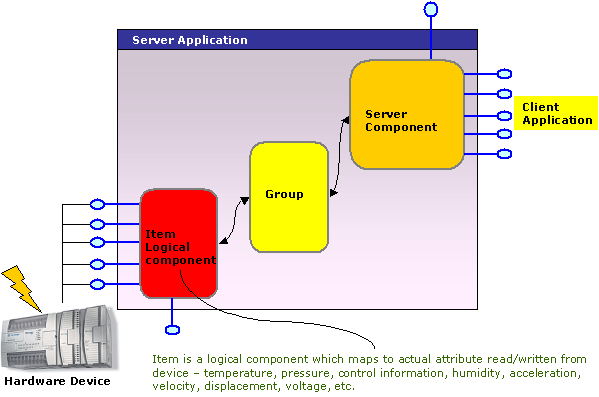
Figure 1.
,
etc) -->
Introduction
COM/OLE applications are widely used in
Industrial Automation and Process Control domains.
Since not many programmers are aware of these
technologies, I thought to share my experience in
OPC and most developers would love to expand their
knowledge about COM/OLE application areas.
The goal of article: Give simple &
understandable overview of
OPC. More detailed
information and specifications can be downloaded
from OPC Foundation and websites mentioned in
Resources section.
So first, about the above diagram...
Theory about Figure 1:
On left-bottom is a hardware device. It could be
a PLC (programmable logic controller), a
temperature sensor, roller belt controller, or
just about any industrial device. Central part
is the OPC server. Right side is the client that
wants to operate the device. The
OPC
Server gives out standard COM interfaces so that
any client aware of these
OPC Interfaces
can interface with server and operate the device
- without programming
device driver for that hardware.
Hardware can be as varied as
OPC server can
handle and clients can still read and write from
this hardware.
Now back to our
OPC course. This article
gives an overview of
OPC and covers following
topics.
Source code is not available, since most of
server code is specific to hardware. And client
would still need a server to connect to. But yes, if
you want to experiment with
OPC, check out the
Resources section below.
History of OPC
In 1996, a group of companies Rockwell Software,
Intellution, et. al. came together to form a
consortium that defined a standard for process
control. SCADA
and similar standardization efforts were being made
at that time in process control and automation
industry. This group created an initial draft that
was based on Microsoft's Object Linking and
Embedding (OLE). It was called OLE for
Process Control (OPC).
publishes specifications and manages
everything that goes into OPC technology.
Today more than 300 companies are part of
OPC
Foundation. Microsoft, GE, Siemens, Rockwell, ABB,
Ford, Honeywell and more are members that actively
contribute and consume OPC technology.
In 2005, OPC Foundation released
OPC Unified
Architecture draft. There are predecessor drafts
released before - OPC HDA, OPC DX,
OPC AE,
OPC
Commands, OPC Security. We will briefly study them
in this article.
By now, you must have a question in your mind.
Let me answer it below...
Why do we need OPC? its Benefits
I was also a first timer to
OPC (coming from
varied experience in DevTools, eLearning, CAD/PLM,
Multimedia), and had no clue as to why do we need
it. I found that learning it through a case study
was very helpful, so I am going to do the same for
you. To understand the need for standardization in
process control industry, let me give you an actual
case study performed by a giant organization in
Petrochemicals business.
Refer to figure 2. It shows the devices and
software application that were in action on this
particular petrochemical plant.
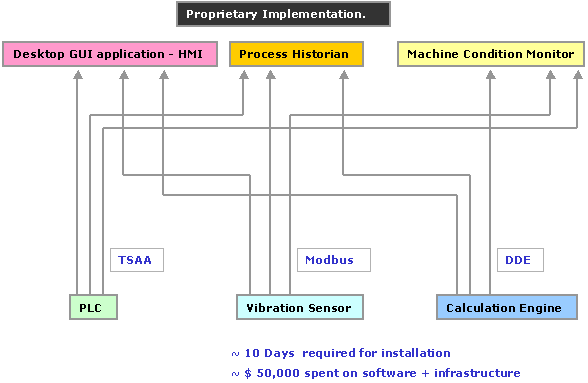
Figure 2.
PLC, Vibration sensor, and Calculation engine work
on different communication protocols - TSAA, Modbus,
and DDE. So the software applications that need data
from these devices also need to be aware of TSAA,
Modbus, and DDE protocol. Additionally each device
needs to serve all the three applications. The
process historian, GUI application providing human
machine interface and the machine condition monitor
all communicating with all devices results in a
complexity. This deployment took the company around
10 days. And its cost was approximately US $ 50,000.
Now, someone like me :) came to them and said,
"hey guys, why don't we think smart and implement as
in Figure 3?". Observe the reduced complexity. Now
all software applications talk only to the OPC
Servers. And all devices also respond only to the
OPC server. OPC Server provides the Black Box
for software applications around hardware.
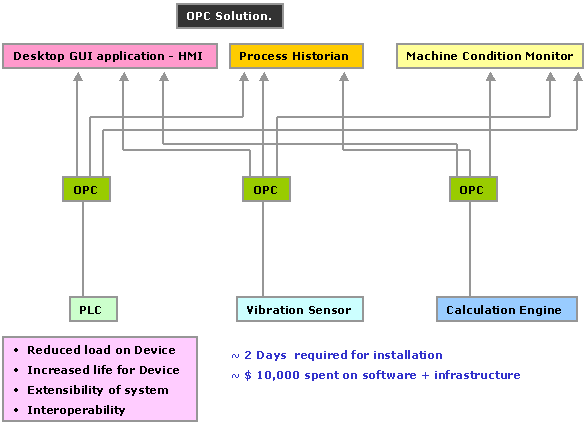
The new implementation took just 2 days to deploy
and cost incurred was approximately US $10,000. They
could have eliminated 2
OPC servers as well and
implemented device drivers right inside a single
OPC
server. This is a tradeoff and off the shelf
OPC
servers may have standard protocols support like
DDE, Modbus and TSAA.
As you observed correctly, the benefits are:
- Reduced load on device.
- Scalability of system has increased.
- OPC server provides caching of data.
- Client applications need not know hardware
protocol details.
- Increased life for device (it need not serve
multiple clients anymore).
- Interoperability (Unix/Linux and Windows -
both platforms are supported by OPC)
- Standardization
Now that you have some insight into
OPC benefits and
history, let's take one step ahead to understand
OPC
terminology and concepts.
OPC Concepts & Terminology
OPC specification defines a consistent
terminology to identify various entities involved.
The best analogy to
OPC way of data representation
is that of a file system hierarchy.
OPC calls it as
OPC Address Space. Within this address space every
entity can be uniquely identified by its
"full-path". For example, refer to figure 4.
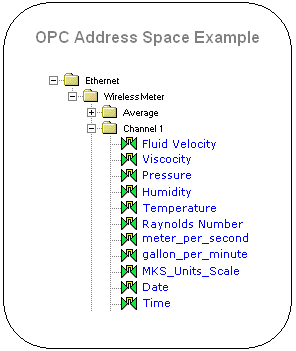 OPC_toolkit.png" width="296" height="351">
OPC_toolkit.png" width="296" height="351">
Figure 4.
OPC Address Space
is hierarchical. It starts with a root. Then there
are logical
folders
and
sub-folders.
Leaf nodes are
OPC Items or
Tags. Generally your sensors and
actuators form the leaf nodes. This is an important
point to understand and we will spend some time on
it. For example, you have a device that can sense
temperature, Pressure, and Humidity. Then these
attributes are generally mapped as leaf nodes under
some folder-subfolder hierarchy. We will see what
that hierarchy can be in a moment. If you have an
actuator (say, Turn_ON_Boiler), then that also
becomes a leaf node. You can write to
Turn_ON_Boiler
values of 1 or 0 for example, and necessary action
will be taken - of course we just assumed that your
hardware control mechanism behaves this way. You can
read from
Temperature
to know sensed value.
Hope we are all clear till this point. Now let's
understand this "logical" folder stuff. The logical
folders and sub-folders are used to represent state
of your Industrial Automation system. This
configuration can actually map to some physical
configuration or even geographical setup. Let's
spend some time to understand this one as well. For
example, in this diagram we have an ethernet
communication channel to which a wireless meter is
connected. And within wireless meter, there are two
classes "Average" and "Channel1". These folders and
sub-folders are very effective means of grouping
your process control parameters and values.
This address space is "published" to all clients
of OPC server. The OPC clients can be simple
spreadsheets like Excel, process historians that
keep record of data coming from various industrial
plant entities. Every client can create a logical
entity called as group
inside OPC server. Each OPC Group can contain
a set of OPC Items.
Synchronous & Asynchronous OPC Item reading
OPC specification supports synchronous as well as
asynchronous reading and writing on hardware
devices. Since not all hardware device operations
are fast-enough, the asynchronous mechanism of
reading and writing to a device comes very handy.
COM Interfaces & Component Categories
Well, so now suppose you wish to write your
first
OPC client. If you were developing a client
that runs on local machine as that of server, and if
you were aware of all
OPC Server ProgIDs, then we
would not have any worries. But since that is not
possible, we need an enumeration mechanism.
Following is an enumeration mechanism.
 Collapse
Collapse |
OPC Component Categories
Enumeration issue is addressed by requiring OPC servers to implement
component categories. For example, all servers that are OPC DA 1.0
(more about this in later sections) compliant implement COM category
with CatID {63D5F430-CFE4-11d1-B2C8-0060083BA1FB}. Similarly the
servers compliant with OPC Data Access 2.0 implement category with
CatID {63D5F432-CFE4-11d1-B2C8-0060083BA1FB}.
So
OPC Foundation distributes a Windows Service
called as
OPCEnum.
 Collapse
Collapse |
Enumerating OPC Servers
OPCEnum.exe runs as a Windows Service and provides enumeration
functionality. Using OPCEnum, the client applications can query
available OPC Servers on local as well as remote networked machines.
Now let's look at server component interfaces.
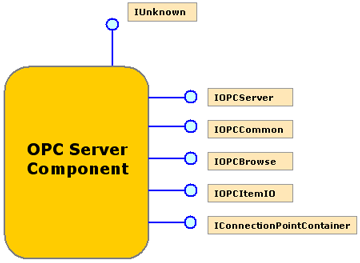
Figure 5.
There are various COM interfaces that
OPC Server
must support according the
OPC Specification
compliance required. These basic interfaces have
specific functionality.
IOPCBrowse This interface has methods that
allow browsing OPC Address Space. Client can query
level by level folders and subfolders till the leaf
nodes. The hierarchy looks like shown in.
IOPCItemIO Interface is used for
performing OPC Item read and write operations.
Now let's understand how OPC Client interacts
with the OPC Server. Important steps involved are
summarized in figure 6, below.
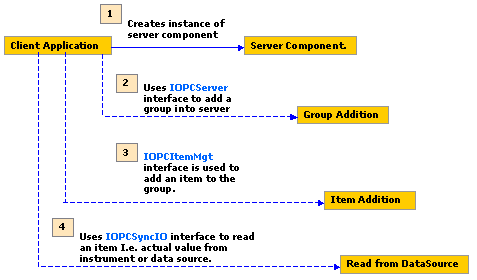
Figure 6.
I know you must still be wondering about this
OPC Group term.
Let's spend some time understanding it. Every client
when opens a session with
OPC Server, needs to
create a logical group of items that it wants to
read or write. Client can maintain multiple groups.
Each group is given a unique name and has following
attributes:
- Update rate [milliseconds] at which the
values of items are read.
- Active or In-active Flag [Boolean] only if
group is active that the items are processed.
- Deadband [%] variations inside this band are
considered NULL.
- IO Mode [Synchronous/ASynchronous] all
operations performed are either sync or async.
- Time Bias [time] local time band with
respect to GMT.
The
OPC Group component supports following
interfaces.

Figure 7.
As you may have identified these IOPCSyncIO etc
interfaces that are relevant for synchronous and
asynchronous OPC Item read and write operations. OPC
Group Components also support connection point
container for events that are used for client
notifications. At least you have some idea by now
that OPC is just another COM application in action -
just that it is a standard meaning all OPC Clients
and OPC Servers are bound by design contract.
OPC Foundation provides compliance test
applications. Using these suites one can execute
certain number of test cases on
OPC Server and
determine their compliance to particular
OPC
Specifications. There are several
OPC specifications
available (explained in next section). A typical
compliance report looks like as shown in figures 8 &
9.
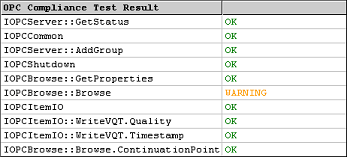
Figure 8.

Figure 9.
OPC Compliance Test Suite also supports testing for
performance whereby the
OPC Server in question is
loaded with multiple items read and write requests.
These determine time required per item operation and
also passed and failed test cases. Once compliance
is achieved, the report can then be uploaded to
OPC
Foundation web site for public reference. So that
customers buying
OPC Server from a particular vendor
can make sure that the server is compliant to a
particular specification and may meet their
integration need with other software packages used
on the plant.
OPC Foundation is responsible for maintaining and
releasing new specifications. It is a body made up
of industry experts, companies that produce
OPC
products and organizations that consume
OPC
products. So far
OPC Foundation has released
following specifications.
- OPC-DA (Data Access) Provides access
to real-time data. We can query most recent
values of temperature, pressure, density,
acceleration, and other types of process control
data from OPC-DA server.
- OPC-HDA (Historical Data Access) Used
to retrieve historical process data for
analysis. This data is typically stored in
archives, databases or remote telemetry systems.
- OPC-AE (Alarms & Events) OPC AE
servers are used to exchange and acknowledge
process alarms and events.
- OPC-DX (Data eXchange) Defines how
one OPC server exchanges data with other OPC
servers.
- OPC-XML (XML Data Access) Defines
schema and data representation format based upon
XML standard. Makes it possible to share &
manipulate process control data across all
operating systems � Windows, Unix, Solaris, etc.
- There were several efforts put onto - OPC
Security, OPC Batch, OPC Commands, OPC for ERP.
Most recently OPC Foundation has released a draft
for OPC
Unified Architecture
that attempts to provide even more integration of
process control data and software with other
industrial software systems like ERP.
There are plenty of resources available on the web
about
OPC.



